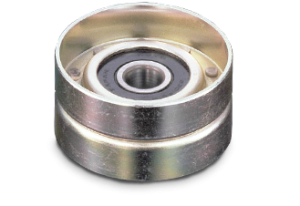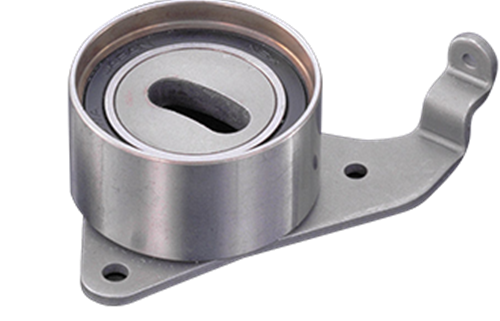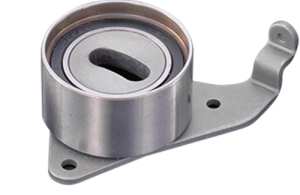TIMING TENSIONER BEARINGS GT80260 PROTON TIARA, PEUGEOT 405

| Manufacturer | Numer | Manufacturer | Numer | Manufacturer | Numer |
| GMB | GT80260 | OE | 820.53 | SKF | VKM 13100 |
| INA | 531003010 | OE | 829.19 | OE | 97522886 |
| INA | F-121287.05 | OE | 829.54 | OE | 97535002 |
| INA | F-121287.1 | OE | 96281179 | INA | F-121287.5 |
The belt tensioner is at the front of an internal combustion engine. A belt-driven outer ring mechanism, including a timing belt, is essential in the set. The tensioner provides tension to the belt, which drives from the crankshaft to the camshaft, alternator, air compressor, power steering pump, and water pump. The tensioner bearing is placed at the slack side.
A tensioner bearing consists of a base, tensioner arm, spring, and pulley. It provides pressure to a timing belt that drives other pulleys while easing the strain on that belt. The belt needs to run at a constant tension to ensure that it is always ensuring that the alternator has enough power to move the pulleys, which drive all these individual components. Other primary functions include:
- Transfer driving force from crankshaft.
- Prevent noise caused by an off-line belt.
- Prevent the belt from slipping.
- Keep the belt-driven mechanism compact.
A tensioner bearing must handle high temperatures, high-speed rotation, and belt vibration because of contiguity in the engine to make the direction of a belt change. These bearings are designed against different specifications from standard deep groove bearings. There are various styles according to engine types. Queen Jen produces four kinds of tensioner bearing: utilized, ball bearing, pulley type, and bracket assembled. Our R&D team develops timing belt tensioner bearings for engines of various car models. We care about the following features in our design:
- Premium materials that ensure reliability and durability.
- Resistance to both high and low temperatures.
- Low torque to minimize the seal friction.
- Optimal seal for preventing grease leakage.
- Tolerance control for alignment
Functions
· To provide belt with tension
· To transfer driving force from crankshaft
· To prevent belt slippage
· To prevent noise caused by off-line belt
· To minimize space of belt layout
Tensioner and idler bearing consists of basic components like inner ring, outer ring, retainer, grease and seal. Pulley may be added to adjust rotation ratio. Bracket may be added to adjust location for adding tension. Races are one of the bearing component parts. It has grooved track for balls to locate. Outer race and inner race make a set. Inner race is situated on sub-assembly unit and outer race is set on housing. Pulley may be added on outer race to provide timing belt system with designed revolution rate. Rolling element is “ball” running between races. Retainer moving along with balls separates individual ball into position. Also grease has important role to reduce friction and oil seal serves to hold grease and shut foreign particles from intrusion.
These are used in the timing belt and auxiliary drive belt to adjust the belt tension or change the belt running path. EASIER’s bearings have a long service life even under high-speed rotation and high-temperature conditions, and their high-strength resin pulleys help to reduce the weight. The timing and auxiliary belts are equipped with idler bearings with pulleys and brackets attached to them. Of these, in the timing belt mechanism, the type with a slotted hole in the inner ring or a bracket for tension adjustment is sometimes called the “tensioner bearing,” and the type without an adjustment mechanism is sometimes called the “idler bearing.” Auxiliary idler bearings are also used in auxiliary drive belt mechanisms. EASIER Can manufacturer and supply Tensioner and Idler Bearings with competitive price and high quality.
E-mail: brandbearings@gmail.com
Tel: 0086-13280450757
Skype: brandbearings
www.china-bearing-manufacturer.com







